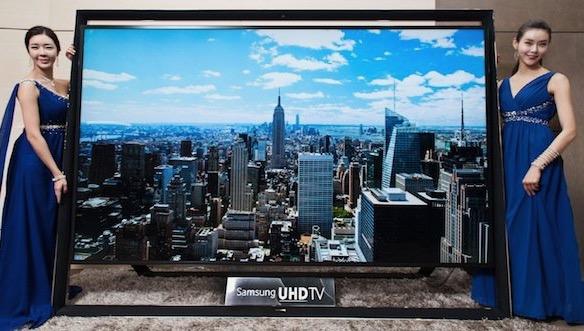The Benefits of Bigscreen TVs Over Projectors

The relatively limited brightness a projector delivers becomes more significant as the size of the screen and the demands of the source material increase. Unlike in the past, where the desire for ever bigger screens could be satisfied (more or less) even by a less than wallet-choking projector, HDR demands far more peak brightness than standard dynamic range. A good 65-inch OLED can produce 600-700 nits of peak brightness, and an LCD even more. A projector is lucky to hit 150 nits (44 foot-Lamberts) and probably a lot less, depending on the projector itself, the screen size and gain, and where in its zoom range the projector’s lens is set (we're talking here of conventional projectors, not the short-throw type). The wide zoom position, which produces the maximum image size, is typically the brightest; to make full use of this fact you must position the projector so that this zoom position fills the screen being used. But up to now this has been a minor factor in most projection setups, which often locate the projector and screen based on other considerations.
Flat-panel TVs in jumbo sizes have become increasingly common lately, at prices far less intimidating than before. A decent 85-inch 4K LCD/LED set can be had for under $3500, though that's a bit smaller than the photo above! An 85-inch 4K OLED isn't yet available, but that might change soon. LG has tested the waters with its 88-inch 8K OLED, but at a choking $30,000 it's not for most of us. A similar 88-inch 4K set should be much less costly, but not cheap. Current 77-inch 4K OLEDs sell for $6000. Can an 88-inch OLED for under $10G be arriving soon? That's hardly pocket change, but , apart from size it might offer a better picture (particularly in black levels color volume, and a genuine HDR experience) than a comparably-priced projector and screen.
Nevertheless, there's a lot to be said for screen size, and a 77-inch or even 88-inch 4KTV is a far cry from the 110-inch (or bigger!) projection screen enthusiasts crave. But up to this point we've been talking in diagonal measurements. An 85-inch diagonal screen is 74-inches wide. A 110-inch diagonal projection screen is 97-inches wide (for a 16:9 screen the width is 0.87 x the diagonal, and for a 2.35:1 screen the width is 0.92 x the diagonalI've run the numbers). That's a difference of nearly two feet.
It's unlikely we'll see a 110-inch diagonal Ultra HD set any time soon at a price comparable to a that of a good projector and screen. Still even an 85-inch diagonal set offers significant benefits over a comparably-priced projection setup in HDR highlight brightness, the wider color volume that HDR offers, and (in my experience at least) a more precise HDR calibration. While the compromise in screen size needed to achieve these benefits remains daunting, there is a solution, though not a perfect one. Suppose that you sit 10-feet away from that 110-inch diagonal screen. That offers a viewing angle (the front angle that the screen covers in your field of vision) of 43.6 degrees (there are viewing angle calculators on-line that can run this calculation this for youI use myhometheater.homestead.com). With an 85-inch screen at the same viewing distance this drops to 34.3 degrees. But if you move up just 2 feet, at 8 feet from the screen, the viewing angle of that 85-inch set now becomes 42.2 degreesnearly as wide as that 110-inch screen from 10 feet away. And even a little closer, say 9-feet, offers a respectable 38-degree viewing angle with that 85-inch screen.
These on-line viewing distance recommendations are often based on visual acuity vs. source resolution, the latter sometimes a bit out of date given the recent improvements in source material. But they're a good starting place. And apart from visual acuity, there's a comfort factor to screen size that might be more significant. There's no perfect viewing angle for everyone. The THX recommendation for viewing distance from this 110-inch diagonal screen (likely heavily influenced by theatrical presentations) isn't 10-feet but 12.3 feet for a viewing angle of 36-degrees. The SMPTE (Society of Motion Picture and Television Engineers) recommendation is 14.9-feet at a 30-degree viewing angle. Some viewers will be thrilled by a 40+ degree viewing angle, others will feel overwhelmed by it.
If you already own a projection setup and are torn as to whether to replace it with a smaller but still large flat-panel TV, a simple experiment may tell you if this might work for you or not. If your zoom range allows, reduce the size of the image on your screen to 74-inches wide (85-inches diagonal, but it's easier to check this measurement by using the image width). Then gradually move your seat closer until you get the visual immersion and impact you like. But don't move too close. Home theater is both a video and audio experience, and sitting much closer than about 8 feet from the front loudspeakers may compromise your audio by not allowing the individual drivers in those loudspeakers to blend properly before they reach your ears. And moving your seating position permanently may have other consequences as well, both domestic and in the need to re-do any room EQ you might currently be using. Also keep in mind that as you move your seating area closer, off-center viewers will experience more off-angle image degradation with many LCD/LED sets (but not with OLEDor projectors). Life is never simple!






























































